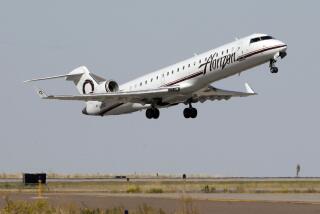Pilot, Co-Pilot Disagree on Events Before USAir Crash : Aviation: A federal panel hears conflicting testimony on aborted takeoff. Questions are raised about who was controlling the plane.
- Share via
NEW YORK — The co-pilot of ill-fated USAir Flight 5050 said Tuesday he thought he was taking off successfully at La Guardia Airport here last September when his pilot usurped control of the jetliner in an attempt to abort the flight.
The jetliner skidded off the end of the runway and broke up on a pier reaching out into the East River. Two female passengers were killed, but 55 other passengers and the crew of six were rescued from the water.
Despite the fact that the Boeing 737-400 was drifting to the left as it accelerated down the runway, “I felt the airplane was in no danger, and I thought the takeoff could be accomplished,” co-pilot Constantine Kleissas told a National Transportation Safety Board hearing. “I had definitely arrested the drift at one point.”
On the other hand, pilot Michael Martin testified Tuesday that it seemed to him that “the rate of veering to the left had increased. . . .
“I jumped in with right rudder,” Martin told the hearing board. “When I did not get the response I anticipated, I made the immediate decision to abort . . . for the safety of the passengers and the plane.”
Martin said he immediately slammed on the brakes, threw the engines into reverse and deployed “spoiler” panels on the wings in an attempt to halt the plane before it reached the end of the rain-slick, 7,000-foot runway.
In other frequently confusing and sometimes conflicting testimony during the first public appearance by either man since the crash:
--Martin said he told Kleissas at one point that “You’ve got the steering,” but Kleissas said he thought the captain had told him, “I’ve got the steering.”
The mix-up apparently led to some confusion as to which man was actually in control of the aircraft at that point.
--Martin testified that he checked the rudder trim prior to takeoff and ascertained that the big fin on the back of the tail was pointing directly amidships, as it should have been.
However, NTSB investigators said Tuesday that the flight data recorder recovered from the cockpit showed that the rudder had been trimmed to the far-left position at takeoff. They said this could explain the plane’s drift to the left as it accelerated on takeoff.
Boeing officials say their records show that the rudder has occasionally been trimmed to the left or right by mistake.
--Martin said he felt comfortable with Kleissas as a co-pilot and considered him fully qualified to fly as a first officer on a Boeing 737-400.
Previously, Martin had told NTSB investigators that Kleissas’ performance on a flight to La Guardia earlier that day “suggested that he was obviously new . . . he missed some radio calls, radio checks.”
Although he had completed all training successfully and was fully rated by the FAA as a first officer, Flight 5050 marked the first time Kleissas had piloted a Boeing 737-400 during takeoff on a regularly scheduled flight without supervision of a training officer.
--Kleissas said he felt comfortable with Martin as his captain and believed that once the pilot had taken over the controls, “I would have to defer to his perceptions.”
Earlier, Kleissas had told New York Port Authority police that he had seen the pilot “babbling” and “mumbling” after the accident.
Kleissas said Tuesday that he regretted using those terms, explaining that the pilot was “talking to himself” about emergency evacuation procedures after the accident.
--Both the pilot and co-pilot defended the 40-hour delay from the time of the accident until they talked to NTSB investigators and submitted urine samples to be analyzed for drugs and alcohol.
Both denied hiding and said they remained at the crash scene as long as they could help with rescue efforts. Both said they agreed to urine samples but declined blood tests on the advice of counsel.
More to Read
Inside the business of entertainment
The Wide Shot brings you news, analysis and insights on everything from streaming wars to production — and what it all means for the future.
You may occasionally receive promotional content from the Los Angeles Times.










